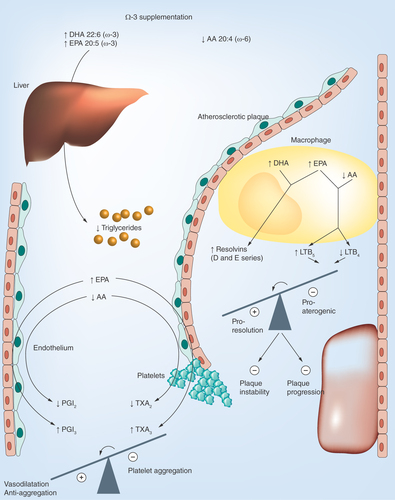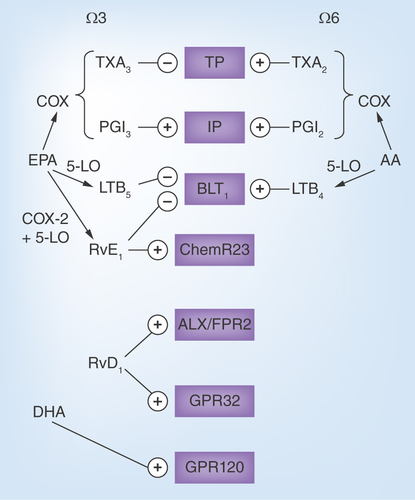Figures & data
Figure 1. Metabolic and vascular effects of omega-3 supplementation.
The circulating levels and cell membrane incorporation of the omega-3 fatty acids, DHA and eicosapentanoic acid (EPA) increase whereas the omega-6 fatty acid, arachidonic acid (AA) decreases. This change in fatty acid profile results in a reduced hepatic secretion of triglyceride-rich lipoproteins and lowering of hypertriglyceridemia. In the atherosclerotic lesion, infiltrating macrophages undergo a lipid mediator switch when omega-3 fatty acids and AA compete as substrates for the lipid mediator biosynthetic enzymes leading to the generation of, for example, the 5-series of leukotriene B (LT), which acts as inhibitors of pro-inflammatory LTB4 signaling. In addition, DHA and EPA serve as the substrate for, for example, the specialized proresolving mediators (SPMs) resolvins of the D- and E-series, respectively. In total, this lipid mediator switch will tip the balance away from inflammation toward proresolution, inhibited plaque progression and increased plaque stability. The competition of EPA and AA for the cyclo-oxygenase enzyme are shown in the bottom left part of the figure. Although EPA-derived thromboxane (TX) A3 from platelets exhibit weaker aggregatory actions compared with its AA-derived analog TXA2, the two prostacyclins, PGI2 and PGI3 are both anti-aggregatory and vasodilatory. Also the latter balance is hence tipped toward a beneficial profile by omega-3 supplementation.
DHA: Docosahexanoic acid.

Figure 2. Examples of the omega-3 and omega-6 metabolome and their receptors.
The cyclo-oxygenase metabolizes arachidonic acid (AA) into thromboxane (TX) A2 and prostaglandin I2 (PGI2, prostacyclin) and eicosapentanoic acid (EPA) into TXA3 and PGI3. Whereas TXA3 inhibits the effects of TXA2 on the thromboxane prostanoid (TP) receptor, PGI3 and PGI2 exhibit similar binding to the I prostanoid (IP) receptor. Similarly, 5-lipoxygenase (5-LO)-derived leukotriene (LT) B4 from AA and LTB4 from EPA exhibit opposing effects on the BLT receptor. Shown in the figure are also examples of specialized proresolving mediators, EPA-derived resolving (Rv) E1 and its receptor ChemR23 as well as DHA-derived RvD1 and its two receptors ALX/FPR2 and GPR32. Finally, the DHA receptor GPR120 is depicted.

